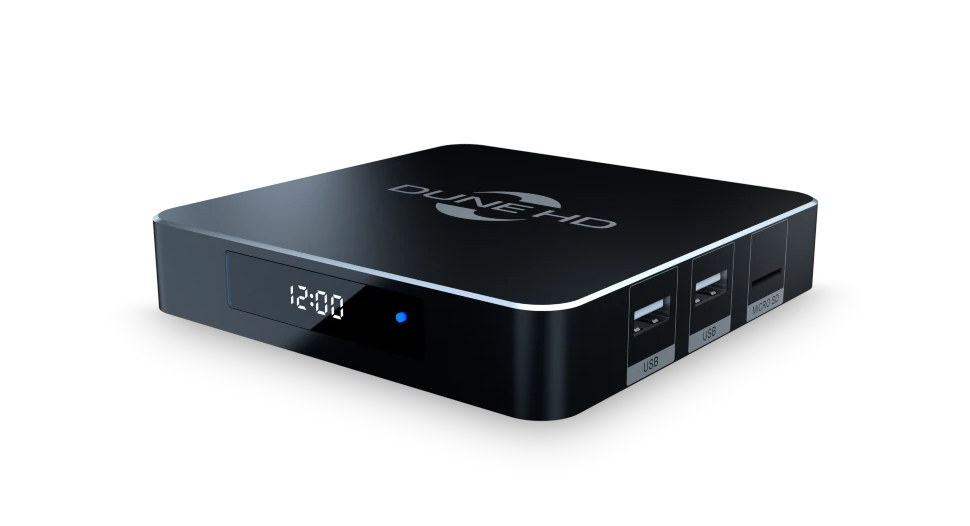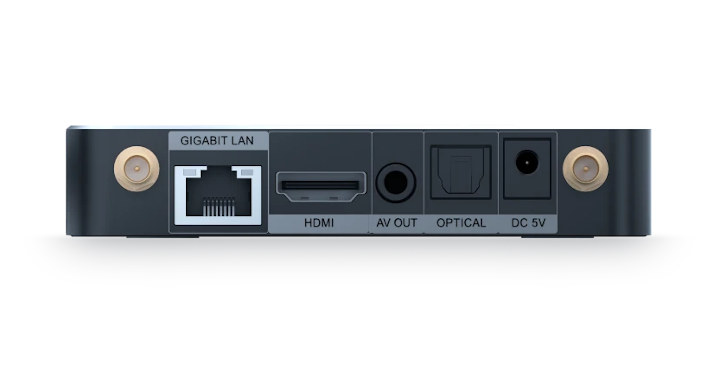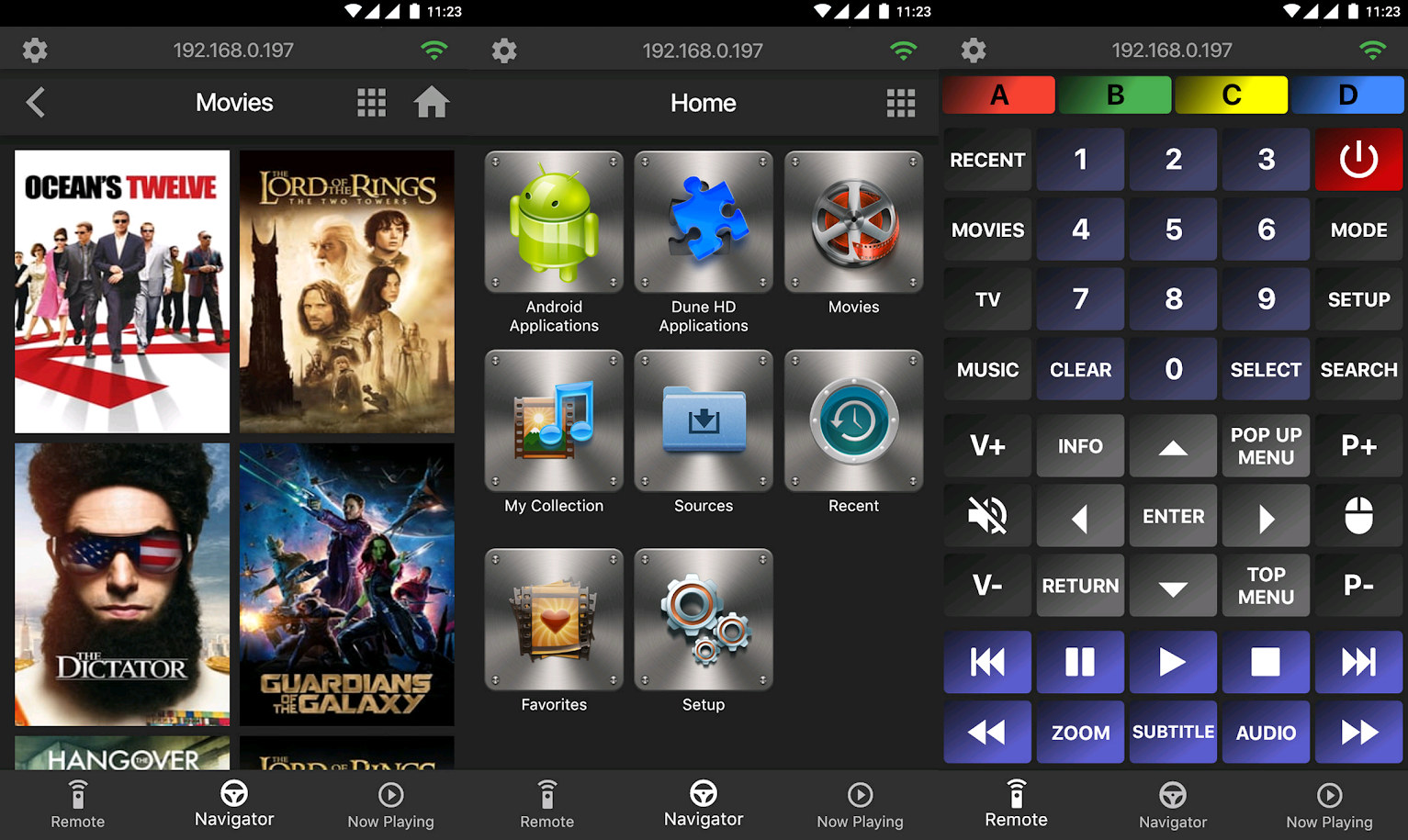Realtek RTD1395 processor is designed for 4K HDR TV boxes and set-top boxes. Equipped with a quad-core Cortex-A53 processor and Mali-470 GPU it offers a lower-cost alternative to Realtek RTD1295 and RTD1296 with the same 4K video processing and playback capabilities.
So far, we had seen it in TV boxes designed for operators and Banana Pi BPI-M4 single board computer, but Dune HD RealBox 4K TV box is the first RTD1395 consumer device sold directly to end-users.
 Dune HD RealBox 4K specifications:
Dune HD RealBox 4K specifications:
- SoC – Realtek RTD1395 quad-core Cortex-A53 processor with Mali-470MP4 GPU
- System Memory – 2 GB RAM
- Storage – 16 GB flash, MicroSD card slot
- Video Output – HDMI 2.0a up to 4Kp60 HDR and AV port (composite)
- Audio – Optional S/PDIF, analog stereo audio via AV port, digital audio via HDMI port; HDMI audio pass-through to AV receiver
- Video Playback
- 4Kp60 HDR/HDR10+ with 10-bit H.265 and VP9 profile-2, 4Kp30 with H.264, and other common video codecs.
- Blu-ray support for BD-J, BD4K, BD3D, full Blu-ray menu navigation or simple BD Lite menu
- 3D video
- Automatic frame rate switching (including 23.976fps video playback)
- DRM – Widevine Level 1 DRM (Netflix is not currently supported at this time)
- Connectivity – Gigabit Ethernet, dual-band 802.11b/g/n/ac 2T2R WiFi 6 and Bluetooth 4.x with two external antennas
- USB – 2x USB 2.0 ports
- Misc – Front panel display
- Power Supply – 5V/2A
- Dimensions – 109 x 109 x 21mm (wall mounting supported)
 Dune HD RealBox 4K runs two operating systems simultaneously: Linux-based Dune HD OS and Android 7.1 with the former aiming to ensure “stable operation and smooth media playback”, and the latter to allow running Android apps. That means you’d actually use a Linux device while playing videos within Dune HD UI, but it would act like a standard Android OS TV box for other apps like web browsers or games.
Dune HD RealBox 4K runs two operating systems simultaneously: Linux-based Dune HD OS and Android 7.1 with the former aiming to ensure “stable operation and smooth media playback”, and the latter to allow running Android apps. That means you’d actually use a Linux device while playing videos within Dune HD UI, but it would act like a standard Android OS TV box for other apps like web browsers or games.
The device also supports Smart Home and Home Automation integration with systems such as Control4 and Creston. Dune Control mobile app for Android and iOS allows you to easily access your video library and control the media player with your mobile phone.

The TV box ships with an IR remote control plus two AAA batteries, a 5V/2A power supply, a 3.5mm AV cables with three RCA connectors for video and audio, an HDMI cable, and a quick installation guide.
Dune HD RealBox 4K is sold for $169 on Dune HD website or about $50 less than the company’s Dune HD Pro 4K TV box based on Realtek RTD1295 processor. You may also be interested in a thread on AVS forum where users discuss the device pluses and shortcomings.
Thanks to Rick for the tip.

Jean-Luc started CNX Software in 2010 as a part-time endeavor, before quitting his job as a software engineering manager, and starting to write daily news, and reviews full time later in 2011.
Support CNX Software! Donate via cryptocurrencies, become a Patron on Patreon, or purchase goods on Amazon or Aliexpress






Why bother at this point?
Are there any AndroidTV tv boxes on the market based on Allwinner h6 or rockchip or amlogic socs with a recent android and an open boot loader?
The closest seem to be the Xiaomis with AndroidTV 6 or 8 and a locked bootloader…
There are a few certified AndroidTV TV boxes, but I’m not sure about open bootloader:
https://www.cnx-software.com/?s=certified+tv+box
Thanks, seems then that mecool would probably be an option, also a locally available minix box.
It’s a pity I didn’t find any kind of aftermarket rom for the TV flavour of android for any kind of affordable SBC…
I just don’t feel like giving my parents an Android (non tv) box with airmouse, too much support required 😉
If just media watching you could consider Roku?
In Europe? Never seen Roku here. On their page im redirected to their UK page, no retailer shipping to my place, so no, not an option.
Basically the aim is to have IPTV like zattoo or local tv stations’ apps, as it seems to work better than their current subscription making troubles when powering up and only working over ethernet, no WLAN…
Well i know they are in France, not sure of rest of Europe
https://www.roku.com/fr-fr/
France and uk only in Europe, so no point in hoping for content for my place/in my language.
Emm…. I have seen 20 dollar boxes with similar specs. Just bought some Amlogic X3 box for 40 which is better in specs than this one.
The price is just unrealistic.
These type of boxes appeal to audio and visual philes. People who have 7.1 audio and home cinemas etc.
The Dune hd real box is fussy about its hdmi cable thats used, and UK distributor sells it for £144.99. The distributor has a good reputation. The dune has several threads elsewhere for many weeks now. disscussing issues in my country.
Tip submitter here:
Dune boxes operate for a different type of market then others – as theguyuk correctly points out, they are more multimedia oriented (and often include HDD bays). Zidoo is another manufacturer of such boxes.
Spec wise the Realbox is interesting because of RTD1395 processor – It was not used for the consumer (so non PayTV market) yet. *
In that sense, Mali 470 MP4 is an interesting GPU – For the longest time Mali 400 MP2/MP4 and Mali 450 MP3 (In Amlogic S9x devices) have been used. Mali 470 improves on performance whilst also consuming less.
It is indeed quite ”odd” that there is now a TV box on the market that does not support OpenGLES 3 like the Mali G31 that is now becoming popular, but at the same time, it could be interesting to denote what the performance of this GPU is.
* I should also note that PayTV providers with their TV boxes usually use the same Amlogic SoC’s as consumers, but also a lot of Broadcom. I find that, as Android TV Guide highlights, that PayTV providers sometimes tend to deviate with their machines by including unique SoC’s you won’t find anywhere else.
Taiwan for instance has a box coming up that has a RTD1611 soc. 6x Cortex A55, Mali G51 MP3. You don’t see that in the TVBox world.
“Mali 470 improves on performance whilst also consuming less.”
Mali 470 is cost effective version of 450 and in performance is worse than 450
Ah… don’t know where you get your facts, but ARM the creator of Mali GPUs has a long standing procedure of naming the GPUs sequentially, for example weaker to stronger performance like Mali-400 > 450 > 470 > 720 > 820 or the newer generation of Mali- G31 > G52 > G72 > G77 .
Nonsense. These are just marketing names.
Let me show you how to find facts: Search for “mali 450 470”, click on the first result pages from ARM and compare the performance at the bottom.
Surprise: Mali 470 is a lot slower than Mali 450 on every measure!
Nope. Lol, you obviously just read data from the ARM specs from their respective webpages, because the “Performance” numbers at the bottom of each GPU page are not a set variable, one page is showing MP1 and the other is MP4 and MP8 data, it is not 1:1 comparison 🙂
Either way I don’t know why you want argue about an ancient GPU, the performance of 450 and 470 is so close. If you were able two do synthetic benchmarks of the GPUs on the same SoC platform the results would be almost identical. The main determining factor for any STB is the software and support. I do own a recent Realtek STB and they are great media players when the software has been supported and maintained. Though, I wouldn’t recommend the device of this article because of the price, if it where maybe for sale at $100 or less then I might consider it. But, the newer SoC’s by Realtek mention by Jean-Luc in the comments below are more interesting with their newer technology like AV1 codec implementation and Android 10 support.
Realtek SoCs seems nice combo of features price ratio?, IF only they go mainline/upstream. Same for every chinese ARM SoC.
Realtek doesn’t have earned itself a good reputation in this respect, so I personally wouldn’t hold my breath.
It looks like Realtek will soon have support for new versions of Android, but for different processors:
RTD1619/RTD1611 will get Android 9.0 and found in devices such as Dune HD Pro 4K II and Zidoo Z9X (and maybe Zidoo “X”)
RTD1319/RTD1311 will support Android 10 for Android TV. AV1 video codec.
Not much information about the processors yet, so I’ll wait before writing more about those in separate articles.